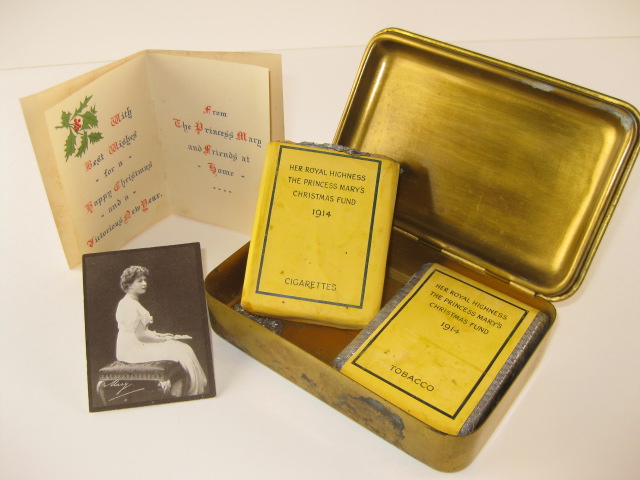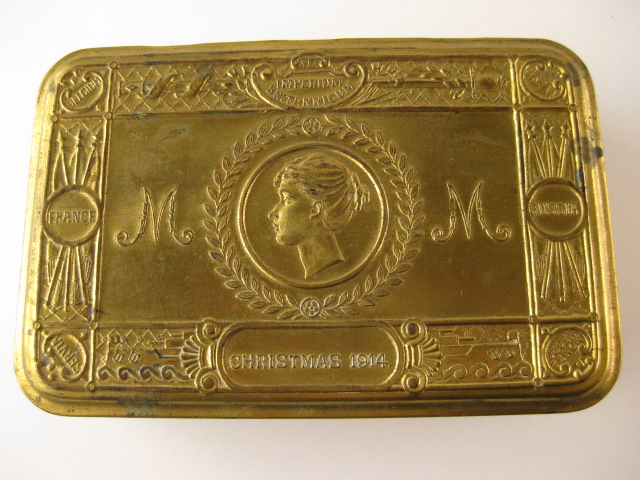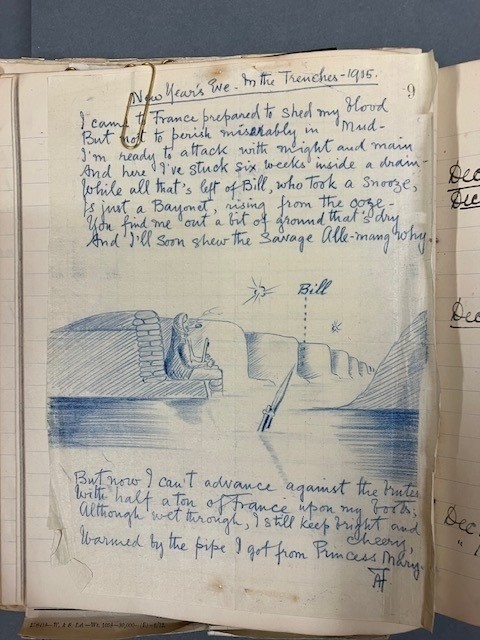By Kate O’Brien, Archives Collections Manager, King’s College London Archives
This mournful piece of doggerel, with its eloquent illustration, is preserved in the World War One diary of Major General Sir William Douglas Smith (ref: SMITH, WD 2/2). ‘AF’ may be Smith’s fellow officer, Major Athel (or Athol) Murray Hay Forbes. I love its mordant, ink-dark sense of humour. Smith’s diaries of his service on the Western Front, 1914-1917, are full of references to the mud: in his entry for 13 December 1914, the ‘trenches were knee deep in mud and in spite of sand bags, fascines and planks the men literally stuck in them & in some cases had to be lifted out’. Just a month later Smith himself fell ‘into a crump hole full of water – up to my waist – gum boots full of water felt just as if I had fallen into a river with waders on’.
The poem’s sardonic final couplet, ‘Although wet through, I still keep bright and cheery/ Warmed by the pipe I got from Princess Mary’, is a reference to the tobacco tin sent to all service personnel on the Western Front and in the Royal Navy from December 1914 (some took many months to arrive), under a scheme devised by Princess Mary, daughter of King George V and Queen Mary. Here is one of those tins, complete with original contents, from the collection of another World War One veteran, Field Marshal Sir John Dill:


The cigarettes have been opened but none extracted, and the loose tobacco is untouched.
For the detailed catalogue to the Smith diaries, please see this link.
For more about daily life in the trenches, see Songs and slang of the British soldier, 1914-1918, by John Brophy and Eric Partridge (London, Scholartis Press, 1930). There’s a reference copy in the Liddell Hart Library, ref: D547.1 B79.
In 1962, the War Studies Department of King’s College London was founded by Sir Michael Howard, lecturer in Military Studies and one of England’s foremost military historians. Two years later, Howard established a Centre for Military Archives at King’s to complement the new department. The Centre’s remit was simple: it would collect the papers of senior defence personnel of the twentieth century. The official launch of this archive was timed for 1964, to commemorate the 50th anniversary of the outbreak of the First World War. In 1973, the archive was renamed the Liddell Hart Centre for Military Archives in honour of Sir Basil Liddell Hart, whose own extraordinary collection of over 1000 boxes of papers is still the single largest, and one of the most often used, in the LHCMA.
2024 thus marks the LHCMA’s 60th anniversary. In those intervening years we have gathered the personal papers of over 800 senior defence personnel, and we thought this birthday year was a great opportunity to showcase just some of the items from the collection. Every month this year we will be publishing a blog post spotlighting one item or collection chosen by a member of staff. We hope you enjoy celebrating with us!
You can read last month’s post about early tank photographs by clicking here.
